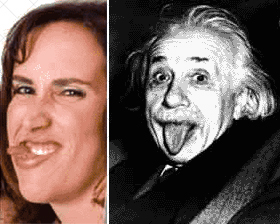Beauty in the Eyes of Einsteinium
Janet Kuypers

Bonus poem from the “Periodic Table of Poetry” series, #099, Es
based on the poems “Beauty in the Eyes of Einstein” and “Einsteinium”
9/30/13
Einstein dismissed some of his theories —
even some we may know all too well.
Einstein didn’t like some of his theories
because he thought they weren’t beautiful.
And I wonder:
what is beauty?
Is it the geomagnetic aberrations
of the Aurora Borealis
dancing along the horizon
at the arctic circle?
Is it the eternally changing
wisps of volcanic trails
in the Saturn moon Titan’s atmosphere?
Or is it converting matter into pure energy
with just the right formula?
We ask, what is beauty?
They say beauty is in the eye of the beholder.
So it makes me wonder…
Einstein understood
that everything was relative…
Because once he fathomed
the relationship
between matter and energy,
once he understood
the interconnectivity
between matter and energy —
he understood that his knowledge
in the hands of evil men
could mean that his Fatherland,
the land he escaped from,
he understood that Hitler and the Third Reich
could be working on an atomic bomb,
converting so little matter
into so much devastating energy.
Einstein understood the gravity
of his writing a letter
to appeal to Roosevelt
to create this bomb,
to protect us from Germany.
Now:
imagine the finality
of naming an element discovered
after the first explosion
of the hydrogen bomb
after
Albert Einstein.
Because really,
in a way,
it’s
ironically
beautiful.
So we ask, what is beauty?
Because chemists will make it clear
that Einsteinium
has no known uses…
But think about it:
is there any logical reason
to grow a certain flower
and purchase it at inflated prices
to give to someone you’re smitten with
on an early date?
Is there any logical reason
to accept the De Beers company
global stranglehold
over stopping the release
of an otherwise common crystal
so that a loved one can cherish
a clear stone on their left finger
to show the world
that they’re otherwise
“taken”?
Is there any logical reason
to claim a song
for a slow dance
on your wedding day?
Logically?
Of course not.
But we do it anyway,
we keep dried rose petals
from that infatuating relationship,
women constantly ooh and aah
over engagement ring sizes,
and married people
intrinsically feel
they have to dance
when they hear
their wedding song.
How illogical.
But how beautiful.
So we ask what is beauty.
And all scientists seem to
use Einsteinium for now
is basic scientific research,
but that seems oddly fitting,
since that is what
Einstein did best.
To think.
To research.
And that
is beautiful.


